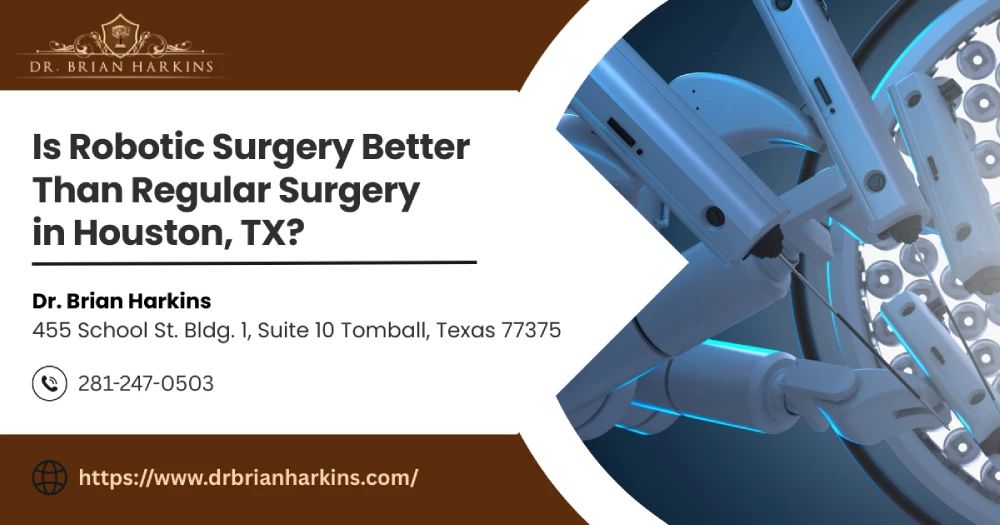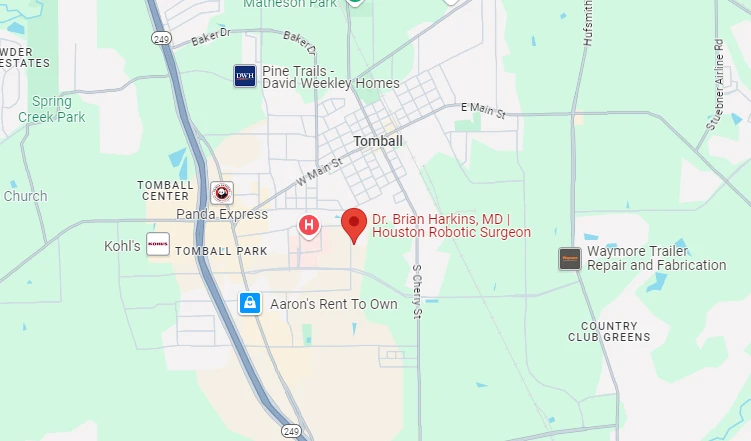
Patients considering minimally invasive procedures often ask: “Is robotic surgery better than regular surgery in Houston, TX?” The short answer? It depends. Robotic surgery—especially the da Vinci surgical system—has exploded across Houston’s operating rooms, yet patients still wonder if this advanced technology is a genuine upgrade over traditional surgical techniques. It’s not universally better; success of robotic surgery depends on the specific surgical procedure, the surgeon’s experience, and each patient’s health goals. For many minimally invasive procedures, a robotic arm guided from a console delivers finer precision, smaller incisions, and faster recovery times. For others, conventional laparoscopic or open procedures remain the gold standard. Below, we compare approaches, outline costs, and help you decide which path best suits your treatment area.
Both robotic and regular laparoscopic surgery aim for identical endpoints—remove disease, relieve pain, and restore function—but they use different surgical instruments and surgical techniques. Houston now hosts one of the nation’s densest clusters of advanced surgery systems, ranging from four interactive robotic arms to cutting-edge 3-D da Vinci vision system displays. Below is how each approach works.
Robotic-assisted minimally invasive surgery employs a computer-guided robotic surgical system—most often the da Vinci Xi. The surgeon sits at a console, manipulating four interactive robotic arms with fingertip controls. The system translates those motions into micro-movements inside your body, filtering tremor and giving the surgeon a high-definition, magnified view of the surgical area. Because the robotic arm swivels with seven degrees of freedom, it can reach deep pelvic or thoracic spaces that standard laparoscopic instruments struggle to access.
Traditional laparoscopic surgery also uses small incisions and a camera but lacks robotic wrists and tremor filtration. For large tumors, emergency trauma, or certain cardiac surgery cases, a surgeon may prefer traditional open surgery to gain tactile feedback and direct visualization. Although open procedures can mean longer recovery, they remain critical when minimally invasive options are unsafe.
| Feature | Robotic-Assisted | Laparoscopic | Open Surgery |
|---|---|---|---|
| Typical Incision Length | ½–1 inch ports | ½–1 inch ports | 4–12 inches |
| 3-D Visualization | Yes (da Vinci vision system) | 2-D | Direct line of sight |
| Instrument Flexibility | 7° wristed robotic arm | Rigid stick tips | Full human hand |
| Average Hospital Stay* | 0–2 days | 0–3 days | 3–7 days |
| Up-Front Cost (Houston Avg.) | +$3–6K | Baseline | Baseline |
| Ideal For | Complex pelvic, colorectal surgery, bariatric | Standard gallbladder, hernia surgery | Massive tumors, trauma |
*Based on 2022–2023 discharge data from Memorial Hermann and Houston Methodist.
Houston’s academic centers publish robust data endorsed by the American Medical Association. When evaluating robotic surgeries versus traditional open surgery, three metrics matter most—complication rate, precision (clean margins), and recovery speed.
Memorial Hermann’s 2023 registry reported a 97% cancer-free margin for robotic prostatectomy versus 94% for open surgery. Robotic colorectal surgery achieved lower blood loss and fewer ostomies than laparoscopic procedures. Yet routine cholecystectomy complication rates remain similar across all methods. Bottom line: use of robotic surgery provides a measurable edge in complex procedures, but simpler cases may not need the extra tech.
Baylor College of Medicine found patients undergoing robotic hysterectomy required 40% less opioid medication and returned to work six days earlier than laparoscopic peers. The combination of smaller incisions, reduced blood loss, and high-definition visualization leads to shorter hospital stays. However, open liver resections still outpace robotic equivalents in total OR time. Your recovery hinges on procedure complexity and surgeon proficiency.
Deciding between robotic surgical and traditional surgery isn’t a coin toss. Several overlapping factors—procedure type, surgeon experience, anatomy, and comorbidities—dictate the smarter approach.
Ask bluntly:
Severe cardiopulmonary disease may limit the steep Trendelenburg position used during robotic-assisted minimally invasive surgery. Obesity, prior operations, and cosmetic scar concerns also influence which approach to surgery is best.
Robotic surgery offers cutting-edge advantages, but you’ll want to calculate whether those benefits outweigh added facility fees. In Houston, robotic procedures may add $3,000–$6,000, primarily for disposable robotic instruments and machine maintenance. Yet shorter recovery and fewer readmissions often erase that gap.
The most sophisticated da Vinci robotic platform can’t compensate for an inexperienced operator. Selecting an expert surgeon remains the single best predictor of surgical success.
Regardless of the type of minimally invasive surgery you choose, focusing on preparation and after-care can significantly improve outcomes and shorten recovery.
Robotic surgery in Houston delivers remarkable precision, less invasive access, and leading-edge technology, yet it is not a universal fix. Your procedure type, surgeon’s experience, medical history, and financial factors all influence whether robotic-assisted or traditional surgery is the smarter choice. Consult with your healthcare provider today to schedule a personalized evaluation and weigh the true pros and cons. By staying informed, you’ll position yourself for safer surgery and a faster return to the life you love.
Robotic surgery can be better for specific procedures—like colorectal, bariatric, or prostate surgeries—offering enhanced precision, reduced blood loss, and quicker recovery. However, it’s not always superior. Whether robotic surgery is better than regular surgery in Houston, TX depends on the type of operation, your surgeon’s experience, and your overall health. Simpler cases may benefit just as much from traditional laparoscopic surgery at a lower cost.
Yes. Surgeons use robotic surgery for complex ventral hernia repair in patients with obesity because the robotic arm’s wider range of motion improves mesh placement. However, adequate space inside the abdomen is essential, so your surgeon will review imaging before proceeding.
The 3-D high-definition view of the surgical area and wristed instruments allow surgeons to perform complex pelvic dissections with cleaner margins and reduced blood loss. These benefits lead to fewer temporary ostomies and faster recovery times compared with traditional open surgery.
Selective Houston programs offer da Vinci robotic mitral valve repair and coronary bypass. The approach uses small incisions between ribs, avoiding sternotomy. Not all cardiac cases qualify; patients with severe calcification may still need open procedures. A cardiothoracic surgeon will determine eligibility.
The surgeon uses hand controllers, foot pedals, and ergonomic finger grips at the console. Each movement translates to scaled, tremor-filtered action at the tip of the instruments. An assistant at the bedside exchanges tools and helps manage the camera.
For complex procedures—particularly prostatectomy and colorectal resections—studies show lower transfusion rates and fewer wound infections with robotic methods. Simpler cases like appendectomy reveal no difference. Outcomes always depend on surgeon experience and case selection.
The American Medical Association issues CPT codes and policy statements that influence insurance reimbursement for robotic surgical procedures. Their clinical guidelines also shape best-practice protocols followed by Houston hospitals.
Robotic surgery is rarely used for acute emergencies like perforated ulcers because console setup takes extra minutes. Traditional open or laparoscopic surgery remains preferable when immediate access is critical for patient survival.
Many patients resume light cardio within two weeks and core strengthening by week four, thanks to smaller incisions and reduced pain. Your surgeon will give you a personalized timeline based on the size and location of the hernia repair.
Current robotic systems are surgeon-controlled tools. They enhance precision but don’t make clinical decisions. The future of surgery will likely feature more automation for suturing and imaging, yet human expertise will remain central for diagnosis and strategy.


Dr. Brian Harkins is a renowned surgeon specializing in advanced, minimally invasive, and robotic surgical techniques. With a dedication to innovation and personalized patient care, he has transformed countless lives by delivering exceptional outcomes.

I want a website like this, where do i start?